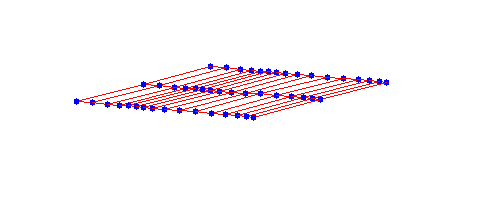Transverse wave
A transverse wave - including transverse , shear or shear wave - is a physical shaft , wherein the vibration perpendicular to its propagation direction is effected. The opposite is a longitudinal or longitudinal wave , in which the oscillation takes place in the direction of the direction of propagation. Examples of a transverse wave are a string vibration or light in a vacuum , while sound in an ideal fluid (approximately in air) is a longitudinal wave.
illustration
A transverse wave oscillates perpendicular to its direction of propagation. The wave can be illustrated using a rope with one end held in the hand. By moving the hand up and down, the rope can be deflected from its rest position and this deflection is propagated along the rope. This is a transverse wave, because the wave spreads horizontally along the rope, but the rope is deflected up and down from its rest position. The wave vector that characterizes the direction of propagation of the wave is thus perpendicular to the amplitude of the rope oscillation.
Instead of moving up and down, a similar wave can be created by hand movements from right to left, or a combination of both directions. Such waves are also transverse waves, but differ in the direction of oscillation. This direction of oscillation of the transverse wave is called polarization .
properties
polarization
In contrast to longitudinal waves , transverse waves can be polarized, as the oscillation is possible in the entire plane that is perpendicular to its direction of propagation. For example, if the shaft runs in the z direction, the oscillation can take place in the x direction, y direction or in any (not necessarily fixed) combination of both directions, i.e. in the complete xy plane. This results in various special cases of oscillation:
- The oscillation only takes place in one direction: In this case the wave is called linearly polarized. If one imagines a wave of rope running towards an observer in this polarization, he sees only one line.
- The amount of deflection is fixed, only the direction of deflection changes with a fixed angular velocity . Here the observer sees a circle; one speaks of circular polarization. Depending on the direction of rotation in which the deflection runs through the circle, a distinction is made between right and left circular polarization.
Elastic waves
The differential equation for the motion of non-dissipation-free elastic waves in a solid can be derived from the Navier-Stokes equation
for the time- and location-dependent deflection . Where , and are constant material parameters. Like every vector field, the vector field can be split into a rotation-free and a divergence-free part:
where applies to the rotation-free part
and for the divergence-free
This gives two separate wave equations for the transverse and longitudinal part of the wave:
with different phase velocities for the longitudinal wave and for the transverse wave. In the same medium, the speed of transverse waves is always lower than that of longitudinal waves.
Examples
Flat transverse wave train
Transverse wave train as a cylindrical or spherical wave
Far field of a linearly polarized, electromagnetic wave in a vacuum that propagates in the x direction. The electric field strength (in blue) and the magnetic flux density (in red) are perpendicular to it.
Media bound
- dilatation-free waves in an incompressible elastic medium (solid)
- Surface waves on liquids, such as water waves , are not pure transverse waves, but rather form a mixture of transverse and longitudinal waves
- Alfvén waves or transverse plasma waves
- Because of the shear stresses that occur, ultrasound in solids also has a proportion of transverse waves in addition to the longitudinal wave component; this is used, for example, in the oblique sound method
- La Ola wave in a football stadium
Not media-bound
literature
- Wolfgang Demtröder: Experimental Physics 1: Mechanics and Warmth . Springer Berlin Heidelberg, 2013, ISBN 978-3-642-25465-9 .
Individual evidence
- ^ B. Lautrup: Physics of Continuous Matter: Exotic and Everyday Phenomena in the Macroscopic World . CRC Press, 2004, ISBN 0-7503-0752-8 , pp. 175 ( limited preview in Google Book search).
- ↑ transverse waves. In: Lexicon of Physics. Spektrum Akademischer Verlag, accessed on September 28, 2015 .
- ↑ compare e.g. B. Arthur Haas : Introduction to Theoretical Physics . First volume, 5th and 6th edition, 1930, Berlin and Leipzig: de Gruyter. Section 49: The elastic waves , pp. 171–172 ( restricted preview ).




















